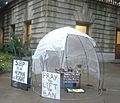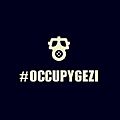Occupy movement facts for kids
Quick facts for kids Occupy movement |
|
|---|---|
| Part of the response to big money problems and to housing loan issues and to the impact of the Arab Spring | |

Worldwide Occupy movement protests on 15 October 2011
|
|
| Date | 17 September 2011 – 2012 |
| Location |
Worldwide (List of locations)
|
| Caused by | Unfair differences in wealth, big companies having too much say in government, and other reasons. |
| Methods |
|
| Arrests/Injuries/Deaths | |
| Arrests: 7,700+ Injuries: 400+ Deaths: 32 |
|
The Occupy movement was a worldwide movement of people. It protested against unfair differences in wealth and power. It also wanted more real democracy around the world. The main goal was to make things fair for everyone. It also aimed to find new ways for people to have a say in how things are run.
This movement had many different parts. Local groups often focused on different issues. But the main concern was how big companies and the world's money system seemed to control things. They felt this system mostly helped a few rich people. They also believed it hurt democracy and was not stable. The Occupy movement was part of a larger "global justice movement."
Contents
What Was the Occupy Movement?
The Occupy movement was a series of protests around the world. People gathered to show they were unhappy with how money and power were shared. They believed that a small number of very rich people and big companies had too much control. This made life unfair for most people.
Why Did People Protest?
People protested because they felt there was a lot of unfairness in wealth. This means some people had a lot of money, while others had very little. They also felt that big companies had too much influence over governments. This made it hard for ordinary people to have their voices heard.
Where Did It Start?
The first big Occupy protest happened in New York City. It was called Occupy Wall Street. Wall Street is a famous street where many big financial companies are located. This protest started on September 17, 2011, in a place called Zuccotti Park.
By October 9, 2011, Occupy protests were happening in over 951 cities. These protests took place in 82 different countries. In the United States alone, over 600 communities had Occupy protests.
How Did the Protests Spread?
Even though the movement was most active in the United States, it quickly spread. By October 2011, protests and occupations had started in many other countries. These protests happened on every continent where people live.
For the first month, police mostly left the protesters alone. But this changed around October 25, 2011. That's when police first tried to remove protesters by force in Occupy Oakland. By the end of 2011, most of the main protest camps were cleared by authorities. The last big camps in Washington, D.C. and London were cleared by February 2012.
What Inspired the Movement?
The Occupy movement was inspired by other protests around the world.
- It took ideas from the Arab Spring. These were big protests in Arab countries.
- It was also inspired by the Green Movement in Iran in 2009.
- The Spanish Indignados Movement also played a part.
- The movement was also part of a larger wave of protests against government spending cuts that started in 2010.
Common Slogans and Tools
The movement often used the slogan "We are the 99%". This meant that 99% of people were struggling, while 1% had most of the wealth. They also used the #Occupy hashtag format online. They organized their efforts using websites like Occupy Together.
Impact and Recognition
On October 12, 2011, the Los Angeles City Council showed its support for the Occupy movement. It was one of the first government groups in the U.S. to do so.
In October 2012, a director from the Bank of England said that the protesters were right to criticize. He felt they had convinced bankers and politicians "to behave in a more moral way." This showed that the movement had an impact on important people.
The Occupy movement is an international protest group. It stands against unfairness in society and money. Many groups around the world copied the way the New York City-based Occupy Wall Street movement worked. These protests continue to happen in different forms across the world.
Images for kids
-
Occupy protesters with "We are the 99%" signs in Bennington, Vermont
-
Protesters with the "99%" t-shirts at Occupy Wall Street on 17 November 2011 near the New York City Hall.
-
The General Assembly meeting in Washington Square Park, New York City, on 8 October 2011
-
Green party leader Caroline Lucas discussing green economics with occupiers at London's Bank of Ideas on 6 December 2011
-
Mashtots Park activists protesting in front of the city hall of Yerevan, Armenia
-
Protesters occupy the roof of the National Congress of Brazil in Brasília on 17 June 2013.
-
Tents at the Occupy Buffer Zone camp in Nicosia
-
Occupy Berlin protests on 15 October 2011, pictured in front of the Reichstag
-
The Occupy Auckland protest camp in Aotea Square, Auckland, on 16 November 2011
-
The Occupy Dame Street camp in Dublin, Republic of Ireland
-
Some of the protesters have styled themselves as #OccupyGezi.
-
A tent at the Occupy London encampment in the City of London

























